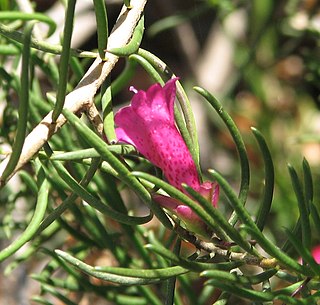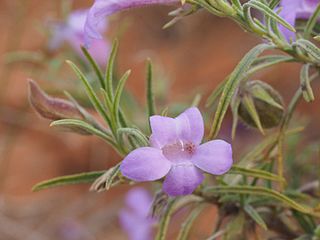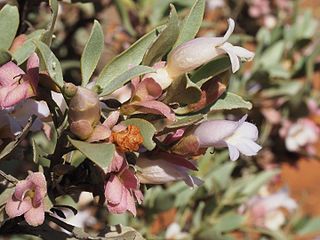
Eucalyptus eremophila, commonly known as the sand mallet or tall sand mallee, is a species of mallet that is endemic to semi-arid regions of Western Australia. It has smooth pale brown and greyish bark, narrow lance-shaped to elliptical adult leaves, flower buds arranged in groups of between seven and eleven with an elongated operculum, and cup-shaped to barrel-shaped fruit.

Banksia repens, the Creeping Banksia, is a species of shrub in the plant genus Banksia. It occurs on the south coast of Western Australia from D'Entrecasteaux National Park in the west to Mount Ragged in the east.

Banksia proteoides, commonly known as king dryandra, is a shrub endemic to Western Australia. It was known as Dryandra proteoides until 2007, when all Dryandra species were transferred to Banksia by Austin Mast and Kevin Thiele.

Grevillea vestita is a shrub which is endemic to the south-west of Western Australia.

Eremophila alternifolia, commonly known as narrow-leaved poverty bush, is a plant in the figwort family, Scrophulariaceae, and is endemic to areas between the far west of New South Wales, the far south of the Northern Territory and the southern half of Western Australia. It is a variable shrub, with respect to its growth form, leaf shape and flower colour. Aboriginal Australians used the leaves to treat ailments such as colds and skin infections and pharmacological testing has shown that the leaves contain compounds that affect cardiac activity.

Eremophila bignoniiflora, commonly known as Bignonia emu bush, creek wilga, dogwood, eurah, gooramurra, kurumbimi and river argee is a plant in the figwort family Scrophulariaceae and is endemic to the Northern Territory and all mainland states of Australia. It is a spreading, weeping shrub or small tree with long, strap-like leaves. Its leaves are among the longest in the Eremophila genus and the flowers are also relatively large, reflecting their adaptation to pollination by birds.

Eremophila latrobei, commonly known as crimson turkey bush, native fuchsia, Latrobe's emu bush, grey fuchsia bush, warty fuchsia bush and Georgina poison bush is a flowering plant in the figwort family, Scrophulariaceae and is endemic to Australia. It is an erect, highly branched shrub with usually linear leaves and red to purple-red flowers and which occurs in all mainland states, including the Northern Territory but excluding Victoria.
Banksia undata var. splendens is a shrub endemic to Western Australia.

Enchylaena tomentosa, commonly known as barrier saltbush or ruby saltbush, is a small native shrub of Australia.

Banksia sessilis var. cordata is a variety of Banksia sessilis, with unusually large leaves and flower heads. It is a rare variety that is restricted to the extreme south-west corner of Western Australia.

Banksia sessilis var. cygnorum is a variety of Banksia sessilis.

Brachyscome ciliaris, commonly known as variable daisy, is a small bushy perennial herb with a prominent flower, which occurs throughout most of temperate Australia

Erodium cygnorum is a species of herb native to Australia.
Euphorbia tannensis subsp. tannensis is a species of herb or shrub native to Australia and some Pacific islands.
Euphorbia tannensis subsp. eremophila, commonly known as desert spurge, is a subspecies of herb or shrub native to Australia.
Euphorbia tannensis var. eremophila is the more widespread variety of E. tannensis subsp. eremophila.
Euphorbia tannensis var. finlaysonii is a variety of desert herb native to Australia.
Eremophila annosocaulis is a plant in the figwort family, Scrophulariaceae and is endemic to a small area of Western Australia. It grows on low, rocky hills near Laverton.

Eremophila gilesii, commonly known Charleville turkey bush, green turkey bush, desert fuchsia and Giles emu bush is a flowering plant in the figwort family, Scrophulariaceae and is endemic to Australia. It is usually a low, spreading shrub with pinkish-lilac to purple flowers and is widespread in the Northern Territory and all mainland states except Victoria. It is considered a difficult agricultural weed in some parts of Queensland but is often used as a bush medicine by Aboriginal people.

Eremophila tietkensii is a flowering plant in the figwort family, Scrophulariaceae and is endemic to Australia. It is a rounded to flat-topped shrub with grey-green leaves, usually pinkish-purple sepals and mauve, pink or lilac-coloured petals. It is mostly found in Western Australia but also occurs in the far west of the Northern Territory.













